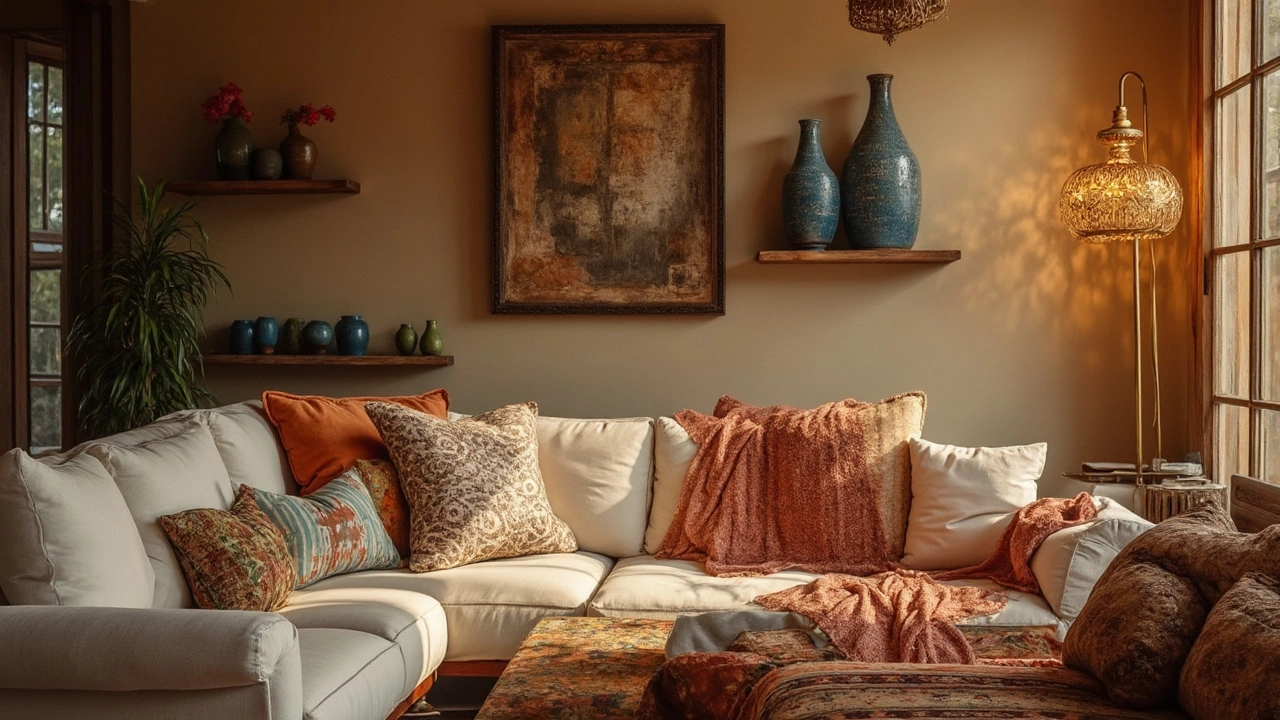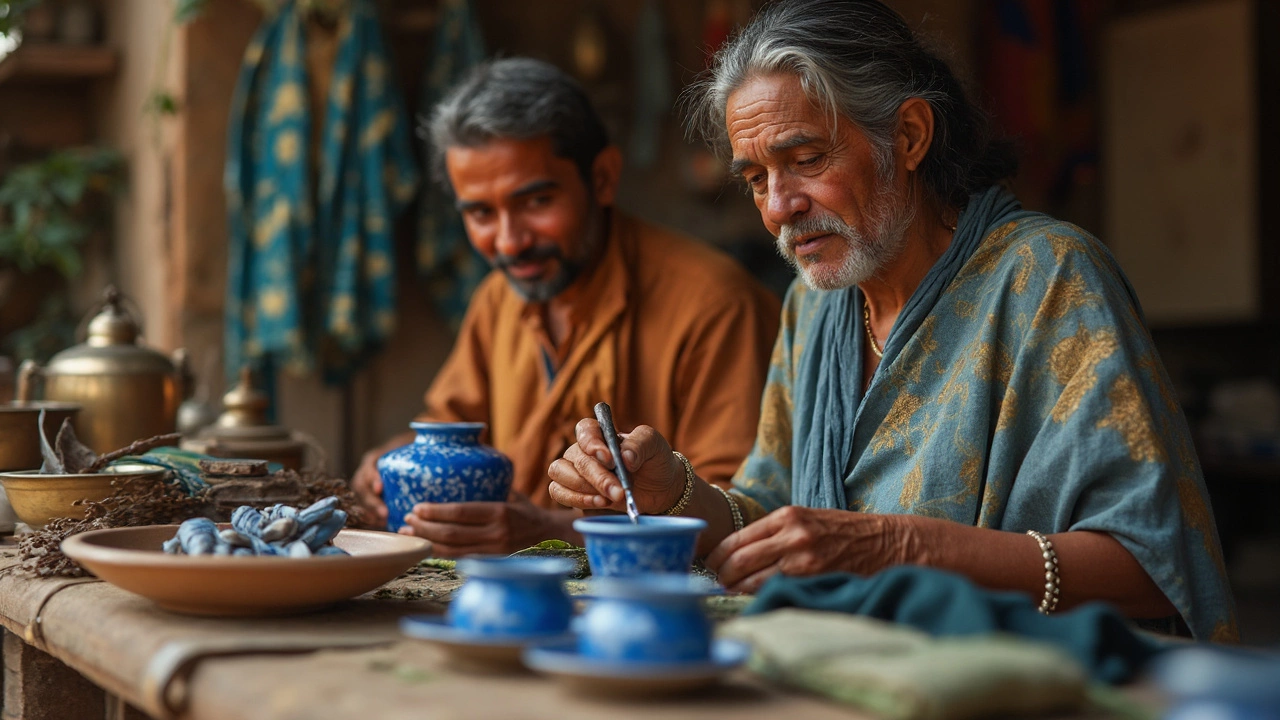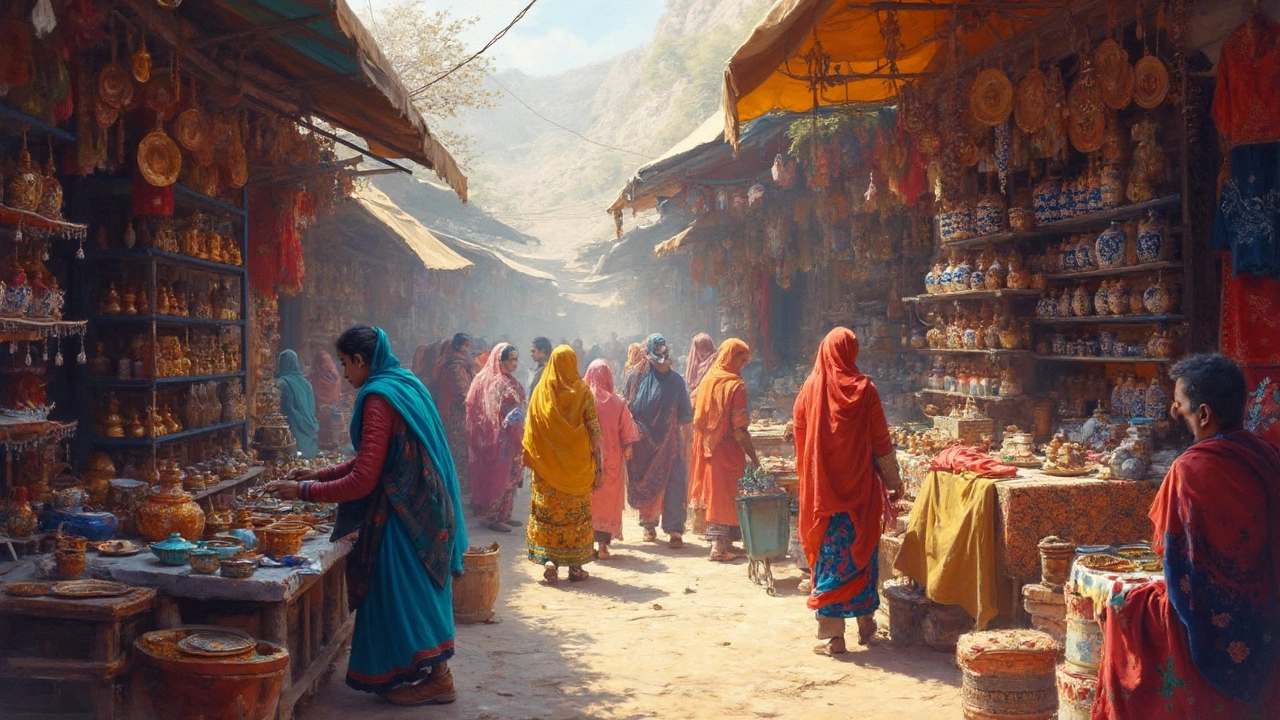Step into any Indian market, and it's like walking into a live art show. India isn’t just a country—it’s a non-stop workshop, turning out handicrafts people from across the globe line up to buy. If you’ve ever wondered what puts India on the map when it comes to handmade products, you’re not alone. You won’t just find souvenirs—these pieces are packed with tradition, skill, and hidden details that make each one special.
Ever wondered why certain shawls, pots, or bangles have such a reputation? It’s not random. Every item has a story behind it, and some have been perfected over hundreds of years. Whether you’re a traveler looking to take home more than photos, or someone shopping online for something real and unique, knowing what separates a true Indian craft from a mass-produced knockoff can save you a lot of trouble and money.
- Why Indian Handicrafts Stand Out
- Must-Know Crafts and Their Regions
- How These Products Are Made
- Tips for Buying Authentic Handicrafts
- Bringing Indian Handicrafts into Modern Life
Why Indian Handicrafts Stand Out
What makes Indian handicrafts a hot favorite, not just in India, but all over the world? It boils down to a mix of tradition, crazy good skills, and serious attention to detail. Most of these crafts get passed down through families, so you’ll find techniques in use today that have survived hundreds—sometimes even thousands—of years. We’re talking proper old-school craftsmanship.
India’s crafts scene is wild because each region has its own thing going. For example, Kashmir is all about pashmina shawls, Jaipur rocks blue pottery, and Varanasi is famous for handwoven silk saris. These aren’t just pretty items; people still use them daily in Indian homes. Plus, Indian artisans often use stuff from nature, like clay, wood, and even recycled materials. That’s partly why these products are so unique—you won’t find the same patterns and colors anywhere else.
Here’s a number that might surprise you: India exports about $4 billion worth of handicrafts every year. That chunk includes everything from traditional jewelry to carved wooden furniture. This might not sound huge next to big tech exports, but it means millions of people rely on Indian handicrafts for their income.
| Key Fact | Detail |
|---|---|
| Handicraft Export Value (2023) | $4 billion |
| Main Export Markets | USA, UK, Germany, UAE |
| Employment in Sector | 7+ million artisans |
The real kicker is the diversity. Walk down a street in Delhi or a small village in Rajasthan, and you’ll run into different craft styles within a few hours. The sheer variety means you can keep discovering new stuff each time you visit or even browse online shops run by local artists.
In short, these handicrafts stand out because they’re not just cool to look at—they’re a big deal for the people making them, they support old traditions, and they’re worth real money for the country. If you’re after something truly handmade with a backstory, this is the place to start looking.
Must-Know Crafts and Their Regions
If you’re thinking about Indian handicrafts, location is everything. Each region in India claims its own signature craft, shaped by local history, weather, and even the kind of soil or metal found there. Here’s what stands out from some iconic places—no guesswork, just the straight facts.
- Kashmir – Pashmina Shawls & Papier-Mâché: Kashmir is famous for genuine pashmina—made from the undercoat of Himalayan goats. Only a small amount of raw pashmina is produced worldwide, and half comes from this state. Plus, look for handcrafted papier-mâché boxes covered in bright, floral patterns—a Kashmiri staple.
- Rajasthan – Blue Pottery & Block-Print Textiles: Jaipur’s blue pottery uses unique quartz-based clay, not regular terracotta, making it stand out. Sanganer and Bagru, near Jaipur, are the real deal for hand block–printed fabrics, used for everything from bedsheets to scarves.
- West Bengal – Kantha Embroidery: Ancient quilting skill, but way more stylish. Women stitch old saris into layers, giving them a second life with quirky patterns. Shantiniketan leather goods also win awards for their hand-painted surfaces.
- Uttar Pradesh – Brassware & Chikan Work: Moradabad makes world-famous brass lamps and décor, shipped everywhere from the US to the Middle East. Lucknow’s chikan embroidery is delicate but hard-wearing—a favorite for formal Indian wear.
- Tamil Nadu – Tanjore Paintings & Bronze: The town of Thanjavur produces paintings with real gold foil—these have adorned palaces since the time of the Marathas. Tamil bronze icons are so sought after, several have landed in global museums.
If you’re curious which states are export leaders, here’s a table with top contributors for major crafts:
| Region | Main Craft | Global Export Share (%)* |
|---|---|---|
| Jammu & Kashmir | Pashmina, Papier-Mâché | 22 |
| Rajasthan | Blue Pottery, Textiles, Jewelry | 18 |
| Uttar Pradesh | Brassware, Chikan Work | 24 |
| West Bengal | Kantha, Leather | 10 |
| Tamil Nadu | Bronze, Tanjore Painting | 8 |
*Estimates based on reports from India's Export Promotion Council for Handicrafts, 2024.
These numbers aren’t just trivia—they tell you where the best stuff comes from. If you want the real thing, track down the region where it’s made. Cheap imitations just don’t hold up to the originals from these local experts.

How These Products Are Made
If you break it down, every Indian handicraft begins with raw, simple materials—think cotton threads, clay, metal sheets, wood, or glass. What makes the magic happen is the skill in the hands of each artisan. No two regions work exactly the same way, but a few patterns show up often.
Take pashmina shawls from Kashmir. These are spun using the super-fine wool from pashmina goats, mostly found in high Himalayan regions. Spinners use a traditional wooden wheel—called a charkha—to turn raw wool into soft threads. It can take up to three months just to finish one shawl. There’s a reason real pashmina costs what it does.
Over in Rajasthan, blue pottery stands out for its bold colors and glassy finish. Potters mix quartz stone powder, powdered glass, and natural gum to make the dough, skipping regular clay entirely. Each piece is hand-molded, then painted with cobalt oxide, fired in a kiln, and finally glazed for that signature shine. A lot of the designs use floral patterns that have been around for centuries.
Brassware from Moradabad is hammered and etched by hand. Artisans use sheet metal and shape it into trays, lamps, and more, working with tools you won’t find in a factory. It’s slow going—some tricky pieces take weeks. With every tap and scratch, the design comes to life.
Most of these Indian handicrafts rely on families preserving old-school methods. Techniques like block-printing, weaving, or stone-carving are often passed from parents to kids, generation by generation. It’s not just about following instructions; each artisan brings their own twist, which is why two items, even from the same family, just never look exactly the same.
If you really want to spot the good stuff, look for little imperfections—tiny bumps in pottery, uneven stitches in shawls, or slight design differences. These aren’t flaws. They’re proof that a real human made your piece the old-fashioned way, and not a giant machine cranking out thousands at once.
Tips for Buying Authentic Handicrafts
Nothing stings quite like finding out your "handmade souvenir" was actually churned out in a faraway factory. India's craft scene is epic, but it's also a playground for fakes, especially in tourist-heavy spots. So how do you make sure you’re getting the real deal when shopping for Indian handicrafts?
- Do a bit of homework before you buy. Some regions are famous for specific crafts—think Kutch for embroidery or Jaipur for blue pottery. If you know what’s local, it’s easier to spot a dud.
- Look for government labels. Genuine crafts often carry "Geographical Indication" (GI) tags, or certifications from bodies like the Handicrafts Development Board or Cottage Industries. They’re a quick way to tell if you’re getting something authentic.
- Inspect the details closely. Machine-made stuff usually looks too perfect. Real handmade crafts have tiny quirks—uneven patterns, slight color differences, little sign of a human touch.
- Bargain, but stay realistic. If the price seems suspiciously low, it probably isn’t real. Good crafts take time, and that time costs money.
- Don’t be shy—talk to the artisan. If you can, buy directly from the maker. Ask how it’s made, what tools are used, and how long it takes. Most artisans love sharing their stories, and fake vendors will usually dodge your questions.
- Check return policies and online reviews. When shopping online, stick to trusted websites and check what other buyers say. Big platforms sometimes have positions for "Craftmark" or similar certifications.
Curious about what gets exported the most? Here’s a snapshot of India’s top handicraft exports by type in 2024:
| Product Type | Major Export Destinations | Export Value (USD Millions) |
|---|---|---|
| Handmade Carpets & Rugs | USA, Germany | 1700 |
| Embroidered Textiles | UAE, UK | 1200 |
| Wooden Handicrafts | USA, France | 900 |
| Imitation Jewelry | USA, Singapore | 650 |
| Metal Crafts | USA, Australia | 580 |
Spotting the real stuff isn’t rocket science, but it takes a little patience and a willingness to look past the flashy displays. Take your time, ask questions, and you’ll go home with something worth way more than its price tag. Nothing beats owning a slice of culture that’s been made the traditional way.

Bringing Indian Handicrafts into Modern Life
Handicrafts aren’t just for display cases or dusty corners. Today, these traditional items fit right into modern homes, offices, and wardrobes. Think about it: a block-printed tablecloth can change up your dining vibe instantly, while a brass diya looks just as cool on a modern bookshelf as it does during Diwali.
The world is catching on. Did you know the Indian handicrafts industry was valued at over $4 billion in exports alone in 2023? Urban designers now pair handwoven dhurries with Scandinavian furniture, and fashion brands drop limited-edition lines inspired by Rajasthani embroidery. It’s not about old vs. new—these crafts actually mix with current trends and help spaces feel more personal.
Looking to add some Indian handicrafts to your life? Here’s what works best and where:
- Pashmina shawls: Not just for winter; they make killer throws on a couch or bed.
- Blue pottery: Bright bowls or vases add a splash of color to any room.
- Terracotta planters: Going green? Hand-thrown pots are perfect for small home gardens.
- Parsi embroidery: Wall hangings or cushion covers bring a pop of texture to your space.
Keeping things real is key. For anything handmade, check labels or ask about where it’s from, especially online. Here’s a quick look at which Indian cities are best for certain crafts, so you know where the good stuff comes from:
| City/Region | Famous Craft | Everyday Use |
|---|---|---|
| Kashmir | Pashmina Shawls | Scarves, home throws |
| Jaipur | Blue Pottery | Crockery, flower pots |
| Kutch (Gujarat) | Mirror Embroidery | Bags, cushion covers |
| Moradabad | Brassware | Decor, lamps, trays |
| Tamil Nadu | Bronze Idols | Tabletop art pieces |
Tip: Skip anything that looks too perfect. The charm in Indian crafts is in the slight quirks—tiny paint smudges, handwoven textures, or small color differences.
Big brands like Fabindia and Jaypore make it easier to shop straight from artisans. Or, hit up local fairs and haats if you’re in India. Every rupee you spend helps real people keep these crafts alive while your home or style gets a serious upgrade.
